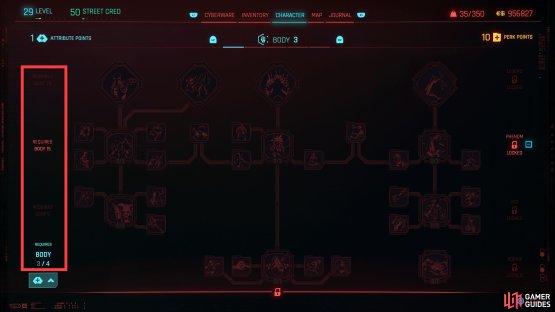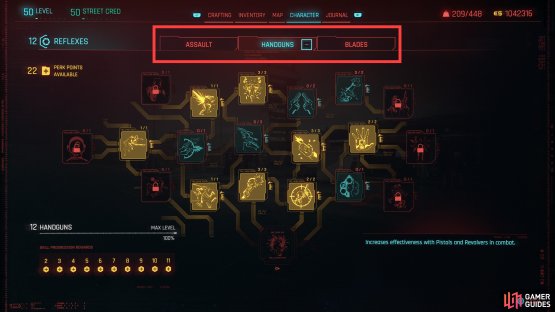One of the fundamental building blocks of any build in Cyberpunk 2077, the various perk trees in the game - like most other major gameplay elements - have undergone significant changes for patch 2.0. These changes haven’t changed their significance when it comes to character development, but none of the perk trees function exactly the same way anymore. With the removal of individual perks, playstyles and every subtree, and numerous changes to interconnected stats like Attributes and Skills, CDProjekt Red has definitely adopted a “less is more” mantra to progression in patch 2.0. This page will discuss all the changes made to perks and perk trees in patch 2.0 of Cyberpunk 2077, comparing the new perk system to the old one in the process.
(1 of 2) In patch 2.0, all perks are sorted into four tiers, which require 4, 9, 15 or 20 points in the associated attribute to unlock.
In patch 2.0, all perks are sorted into four tiers, which require 4, 9, 15 or 20 points in the associated attribute to unlock. (left), Should you have a sufficiently high attribute score, you still must meet other prerequisites, which are indicated by lines connecting each perk. (right)
How Perks Work in Cyberpunk Patch 2.0¶
At a cursory glance, a lot of the core structure regarding perks hasn’t changed; every time you level up you’ll get an attribute point and a perk point. You can spend the former, of course, to improve an attribute - Body, Reflexes, Technical Ability, Intelligence or Cool - and each of these attributes also has an associated perk tree. Each perk tree consists of around 33-38 perks each, which are organized into clusters of perks, with one central perk serving as the prerequisite for several subordinate perks. Some of these central perks have two or even three levels, unlocking escalating bonuses as each level is unlocked. Each level of a perk consumes a perk point, and you must unlock all levels of a central perk before any subordinate perks can be purchased.
For example, in the Reflexes tree is the Air Dash perk, which has three levels and two subordinate perks, Aerial Acrobat and Aerodynamic. You must spend three perk points to unlock all three levels of Air Dash before you can invest in Aerial Acrobat or Aerodynamic. Perks are also segregated into four tiers, Rookie, Pro, Phenom and Legend, and these tiers are unlocked when the related attribute score hits 4, 9, 15 and 20, respectively. Take the Air Dash perk in the previous example; it’s a Phenom-tier perk in the Reflexes tree, hence your Reflexes score must be 15 before you can invest any perk points in it. Finally, perks are also connected vertically, meaning you must invest in lower-tier perks before you can access higher tier ones. These are organized as columns in the perk tree and the red lines should make it clear what each perk unlocks. Once again return to the previous example, the main perk below Air Dash on the Reflexes perk tree is Dash (Pro-tier, requires 9 Reflexes), which has two levels that much be purchased before you can buy any of its subordinate skills or Air Dash, and at Rookie-tier (Reflexes 4+) is the perk Slippery, which must be purchased before you can move onto Dash.
So, to recap, level up to earn attribute points and perk points, spend attribute points to unlock perk tiers (see the table below), and follow the red lines, investing in perks at the bottom of the perk tree to unlock their subordinate perks and the higher tier perks above them.
| Perk Tier | Attribute Required |
|---|---|
| Rookie | 4 |
| Pro | 9 |
| Phenom | 15 |
| Legend | 20 |
(1 of 2) The biggest change to perks is the removal of all perk subtrees - Reflexes perks included the Assault, Handguns and Blades trees, for example.
The biggest change to perks is the removal of all perk subtrees - Reflexes perks included the Assault, Handguns and Blades trees, for example. (left), Despite being haphazardly arranged in a perk subtree, perks were not requirements for other perks, but attributes and skill progression were. (right)
How Are Perks Different in Cyberpunk Patch 2.0¶
Aside from the core concept of “spending perk points to unlock perks”, the perk trees in patch 2.0 have been completely overhauled. Few if any of the old perks survived the shuffle into patch 2.0, and in some cases, entire gameplay modes like “Cold Blooded” from the Cool tree have been discarded. Perk trees were still segregated by attributes and individual perks were gated by their governing attribute’s score (albeit in a less organized manner), but each perk tree had a few (two or three, depending on the attribute) subtrees that were unrelated, each governing a different gameplay aspect. For example, Body had the Athletics, Annihilation and Street Brawler subtrees, and if you just wanted to invest in, say, Athletics subtree perks but didn’t care to use shotguns, LMGs, unarmed strikes, gorilla arms, or anything else governed by the Annihilation or Street Brawler trees, you didn’t have to bother with them.
Each of these subtrees also had a skill tree of the same name, and it should be no surprise that the removal of the perk subtrees corresponded with the skill trees being trimmed down - there were previously twelve subtrees and hence skill trees. Now there are only five attributes, five perk trees and five skill trees. Skill trees weren’t otherwise greatly influenced by perk trees prior to 2.0, but each perk subtree’s ultimate perk did require you to max out each related skill tree before you could purchase said ultimate perk, and since the maximum level you could reach in a skill tree equal equal to that subtree’s related attribute score, you functionally need 20 in an attribute and 20 in a skill to unlock a perk subtree’s ultimate perk - few were worth this investment. It is, however, worth noting that skill trees used to give a lot more perk points as you leveled them, and there were many more skill trees in older versions of the game, so you ended up getting a significant number of perk points from skill trees, although this is somewhat counter-balanced by the fact that there were just a lot more perks in the older versions of the game.
To summarize the patch 2.0 before and after changes to perks:
- Perk trees still require investment in their related attributes, but this is now sorted into four tiers: Rookie (4+), Pro (9+), Phenom (15+) and Legend (20).
- All perk subtrees (Athletics, Handguns, Crafting, Stealth, Breach Protocol, etc) have been removed, although each perk tree offers roughly the same sort of bonuses, except for…
- The Technical Ability perk tree now heavily influences cyberware stats, but most crafting perks have been removed.
- The Intelligence perk tree now has a perk line dedicated to smart weaponry and monowires.
- Perks from the Breach Protocol tree are almost completely removed from the game - daemons aren’t a gameplay element anymore.
- Perks influencing headshots and pistols have been combined and moved to the Cool perk tree.
- The Cold Blood buff, and consequently the Cold Blood perk tree, no longer exist anymore.
- Most old perks have been removed and replaced.
- Some perks are now prerequisites of other perks, and in general each perk tree is more of an interconnected tree with set paths and hierarchies.
- Skill progression no longer affects what perks you can purchase in any way.
- There are fewer perks, and fewer perk points.
- There are no longer any perks that you can sink an unlimited number of perk points into. All perks have 1-3 levels.








No Comments